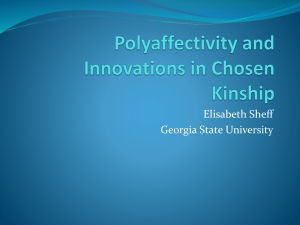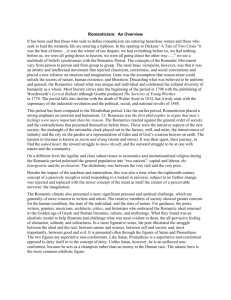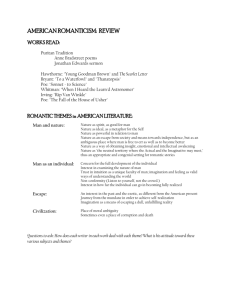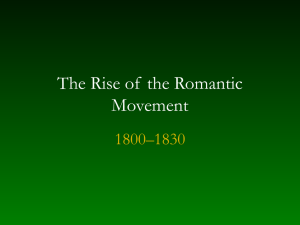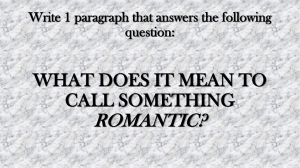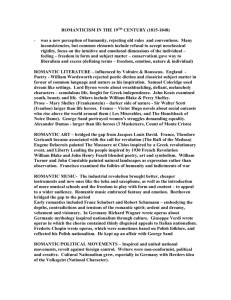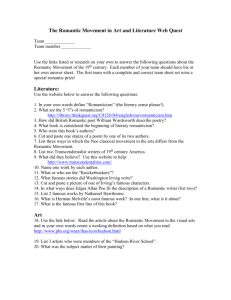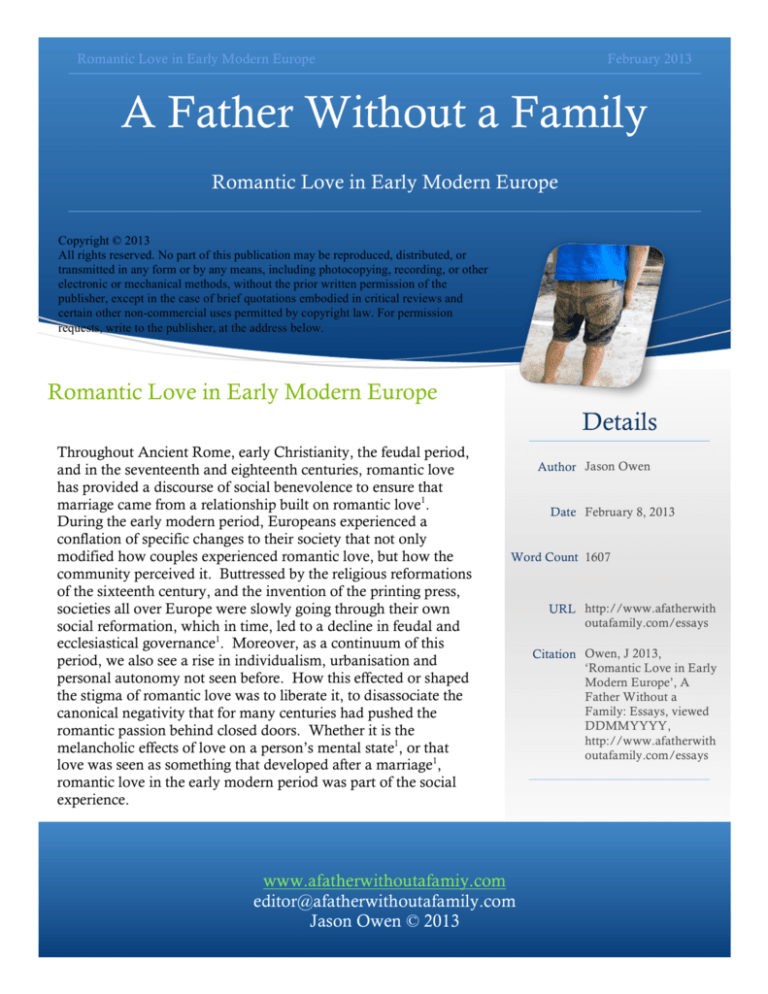
Romantic Love in Early Modern Europe
February 2013
A Father Without a Family
Romantic Love in Early Modern Europe
Copyright © 2013
All rights reserved. No part of this publication may be reproduced, distributed, or
transmitted in any form or by any means, including photocopying, recording, or other
electronic or mechanical methods, without the prior written permission of the
publisher, except in the case of brief quotations embodied in critical reviews and
certain other non-commercial uses permitted by copyright law. For permission
requests, write to the publisher, at the address below.
Romantic Love in Early Modern Europe
Details
Throughout Ancient Rome, early Christianity, the feudal period,
and in the seventeenth and eighteenth centuries, romantic love
has provided a discourse of social benevolence to ensure that
marriage came from a relationship built on romantic love1.
During the early modern period, Europeans experienced a
conflation of specific changes to their society that not only
modified how couples experienced romantic love, but how the
community perceived it. Buttressed by the religious reformations
of the sixteenth century, and the invention of the printing press,
societies all over Europe were slowly going through their own
social reformation, which in time, led to a decline in feudal and
ecclesiastical governance1. Moreover, as a continuum of this
period, we also see a rise in individualism, urbanisation and
personal autonomy not seen before. How this effected or shaped
the stigma of romantic love was to liberate it, to disassociate the
canonical negativity that for many centuries had pushed the
romantic passion behind closed doors. Whether it is the
melancholic effects of love on a person’s mental state1, or that
love was seen as something that developed after a marriage1,
romantic love in the early modern period was part of the social
experience.
Author Jason Owen
Date February 8, 2013
Word Count 1607
URL http://www.afatherwith
outafamily.com/essays
Citation Owen, J 2013,
‘Romantic Love in Early
Modern Europe’, A
Father Without a
Family: Essays, viewed
DDMMYYYY,
http://www.afatherwith
outafamily.com/essays
www.afatherwithoutafamiy.com
editor@afatherwithoutafamily.com
Jason Owen © 2013
[Type text]
[Type text]
Throughout Ancient Rome, early Christianity, the feudal period, and in the seventeenth and
eighteenth centuries, romantic love has provided a discourse of social benevolence to ensure that
marriage came from a relationship built on romantic love1. During the early modern period,
Europeans experienced a conflation of specific changes to their society that not only modified how
couples experienced romantic love, but how the community perceived it. Buttressed by the religious
reformations of the sixteenth century, and the invention of the printing press, societies all over Europe
were slowly going through their own social reformation, which in time, led to a decline in feudal and
ecclesiastical governance2. Moreover, as a continuum of this period, we also see a rise in
individualism, urbanisation and personal autonomy not seen before. How this effected or shaped the
stigma of romantic love was to liberate it, to disassociate the canonical negativity that for many
centuries had pushed the romantic passion behind closed doors. Whether it is the melancholic effects
of love on a person’s mental state3, or that love was seen as something that developed after a
marriage4, romantic love in the early modern period was part of the social experience. This paper will
attempt to show that through a growth of pluralism, and egalitarianism across all demographics,
romantic love did exist in early modern Europe.
The Protestant reformations of the early sixteenth century had in many ways provided a vehicle to
challenge not only the Catholic (Latin) church, but more generally, the social order that was now
coming under increased criticism from all parts of the polity. This challenge to the papacy, to the
hierarchy of the church, set in motion many other changes that in time would lead to the
1
Herman J. Hantz, “Romantic Love in the Pre-Modern Period: A Sociological Commentary," Journal of Social History
15, no. 3 (1982): 351
2
Ruth H.Bloch, "Untangling the Roots of Modern Sex Roles: A Survey of Four Centuries of Change," Signs: Journal of
Women in Culture and Society 4, no. 2 (1978): 238.
3
Merry E. Wiesner-Hanks, Early Modern Europe, 1450-1789. 8th Edition. (Cambridge: Cambridge University Press,
2012), 265.
4
Stephanie Coontz, “Marriage, A History: Chapter 1 - The Radical Idea of Marrying for Love”,
http://www.stephaniecoontz.com/books/marriage/chapter1.htm (accessed January 25, 2012).
enlightenment in the seventeenth century. Other motives included the Black Death, which for so
many people lead them to start to question the power of the Church and by association, God. For
romantic love however, the reformation would unconsciously deliver a seed of individualism that
allowed Christians to over time start to question their faith, rules, norms, and values5. With a rise in
individualism directly proportional to a rise in romantic love, this phenomenon was seen as not only
as a, ‘threat to the moral community’6, but also a challenge to how the church would be able to
maintain its hegemony. Aiding this dissemination of the Protestant reformation was the invention of
the printing press in the mid fifteenth century. This technological advance had a profound impact on
how Europeans communicated, and is directly connected to how the middle class were able to
emancipate themselves from not only Latin as a core language, but as literacy being a tool of the elite
only. The longer-term effects would lead to an increased dissemination in romantic, poetic works, and
by consequence romantic love7. As people were able to be better educated, their minds also opened to
a more pluralist approach to belief, appearance, and sexuality. Feeding this plurality was the
urbanisation of society, which as Hantz argues, ‘furthered to growth of romantic love’8.
The changes to the family unit, how people married, and how lines of kinship would be revolutionised
also allowed romantic love to become more socially acceptable. Historically, a couple’s love for god
was to take prime place in love over all others9. This however was to change, where in time, love for
each other was to be elevated above love for all others. How couples spent their time also shifted
throughout the early modern period. Griffith’s comments on how for people in England during the
sixteenth century, it was not uncommon for them to spend their time, ‘taking long walks together’10, or
spending sleepless nights simply conversing with each other. How these activities were perceived and
5
Weisner-Hanks, 238.
Hantz, 352.
7
Hantz, 349.
8
Hantz, 350.
9
Coontz
10
Paul Griffiths, "Courtship, Sexual Behaviour, and Moral Order,"in Youth and Authority: Formative Experiences in
England 1560-1640 (New York, NY: Oxford University Press, 1996), 259.
6
eventually culturally accepted throughout the early modern period connects us to the increased
autonomy people enjoyed post-reformation. When examining marriage during the early modern
period, property, status, and everything but love were considered as part of the selection process of an
ideal partner. Dowry, and social prestige were also key elements of how the husband’s family might
benefit from such an exchange of vows. All of these ingredients including for the man, being able to
earn descent money, were seen as capitol that, ‘would certainly help love flow’11. As mentioned
above, urbanisation, which in comparison to the village society, allowed other cultural changes to
develop, including marriage and how it was experienced. By taking away the intimate, communal
style world of the village, and moving a more cosmopolitan settlement of the city, both men and
women were able to relieve themselves from the pressures of the patriarchal system of partner
selection. For women, where the social status and burden of male rule mattered most12, the postreformation years provided a gradual change in some social classes, particularly, the upper and ever
growing, middle class. Atkinson supports this when commenting on how different the, ‘attitudes and
behaviours’13 of married couples were as compared to their ancestors. The metaphorical attachment of
marriage being a right of passage to adulthood also underwent a change in the post-reformation years.
This is more evident in the Germanic and Low Countries in Europe where Protestant doctrine was at
its highest.
For many centuries love was seen as a type of illness, this relates back to the four humors and how
they affect both the male and female sexes. For women, they were labelled as being ‘wet and cold’,
with their bodies, ‘producing all sorts of fluids’14. They were also capable of entrapping men to satisfy
their sexual desires. This ‘love sickness’ was taken very seriously if you were thought to have fallen
11
Coontz
Weisner-Hanks, 46.
13
Clarissa W. Atkinson, "Precious Balsam in a Fragile Glass: The Ideology of Virginity in the Later Middle Ages," Journal
of Family History 8, no. 2 (1983): 131.
14
Weisner-Hanks, 42.
12
prey to such an, ‘enchantress’15. Indeed it could be considered a, ‘serious threat to social order’16.
Love, as argued by Coontz, was something that when considering partners was almost,
‘inconceivable’17 because of its fragility and irrational effects on people. Aside from the sickness of
love, there was also the moral conflict that people endured. Hantz argues this definition as, ‘a love
based on personal-emotional attraction, with a strong erotic component which is often repressed
because of moral conflict’18. Mendelson and Crawford detail how during courtship couples would,
‘accompany each other to markets and fairs’19, women would be offered gifts, or weekends away to
entice them away from their fathers. There are however many examples of where moral conflict was
not such an issue for people, one case in point is the well-documented affairs of Giovanni and Lusanna
in Florence during the mid fifteenth century. It is evident here that pre-reformation doctrine still
existed, as for Giovanni, his ‘feelings apparently deepened over time’20 supporting the thesis that love
was seen not as an essential part of a relationship but more a bonus21. Lusanna herself is quoted
commentating on Giovanni’s feelings for her, offering that, ‘Giovanni is passionately in love with
me’22. Finally, love also was seen a precursor to melancholy. This condition brought about by too
much black bile, was to leave the victim depressed, out of love, and filled with sadness. Love sickness
as it were, manifested itself into emotional heartache, social awkwardness, and real treatable medical
conditions. What the enlightenment would bring is a complete revolution in this thinking.
This paper has argued that romantic love did exist in early modern Europe. There are clear
differences in how romantic love was perceived at all levels of society before and after the Protestant
15
Susan Broomhall, Stephanie Tarbin, Women, Identities, and Communities in Early Modern Europe (Aldershot,
Hampshire: Ashgate Publishing, 2008), 115.
16
Coontz
17
Coontz
18
Hantz, 359.
19
Patricia Crawford, Sara Mendelson, "Courtship," in Women in Early Modern England: 1550-1720 (Oxford University
Press, 1998), 111.
20
Gene Brucker, Giovanni and Lusanna: Love and Marriage in Renaissance Florence . 3rd Edition (London: University of
California Press, 2005), 78.
21
Coontz
22
Brucker, 78.
reformations of the sixteenth century. The broad unintentional impact these reformations had along
with the invention of the printing press, are intrinsically linked to romantic love becoming a more
culturally acceptable behaviour. Other social constructs like individualism, and urbanisation enabled a
general emancipation of the genders in the sixteen and seventeenth centuries. This coupled with a
change in the geography of how people lived and how was changing from village style towns, to
cosmopolitan cities also enabled romantic love to be seen as normal culturally acceptable behaviour.
Challenges to the Latin Church from multiple vectors would also play a key part in how all these
factors were perceived. Lastly, in the final decades of the early modern period, Europe would undergo
a scientific transformation that would allow some of these medical and physiological assumptions to
be questioned and ultimately dismissed as untruths.
Bibliography
Albala, K. (2002). Food and Class. In K. Albala, Eating Right in the Renaissance (pp. 184-199). Los
Angeles, CA, USA: University of California Press.
Atkinson, C. W. (1983). Precious Balsam in a Fragile Glass: The Ideology of Virginity in the Later
Middle Ages. Journal of Family History , 8 (2), 131-143.
Beatrice H. Beech, G. T. (2003). A Painting, a Poem, and a Controversy about Women and Love in
Paris in the 1530s. The Sixteenth Century Journal , 34 (3), 635-652.
Bloch, R. H. (1978). Untangling the Roots of Modern Sex Roles: A Survey of Four Centuries of
Change. Signs: Journal of Women in Culture and Society , 4 (2), 237-252.
Brucker, G. A. (2004). Giovanni And Lusanna: Love And Marriage In Renaissance Florence (2nd Edition
ed.). Berkeley, SA, USA: University of California Press.
Brucker, G. (2005). Giovanni and Lusanna: Love and Marriage in Renaissance Florence (3rd Edition ed.).
London, UK: University of California Press.
Camporesi, P. (1989). Bread of Dreams. History Today , 39 (4), 14-21.
Coontz, S. (2005). Marriage, A History: Chapter 1 - The Radical Idea of Marrying for Love. Retrieved
January 25, 2012, from Welcome! - Author Stephanie Coontz:
http://www.stephaniecoontz.com/books/marriage/chapter1.htm
Griffiths, P. (1996). Courtship, Sexual Behaviour, and Moral Order. In P. Griffiths, Youth and
Authority: Formative Experiences in England 1560-1640 (p. 472). New York, NY, USA: Oxford University
Press.
Hale, J. R. (2001). The Renaissance in Europe (2nd Edition ed.). (M. Mallett, Ed.) Oxford, UK:
Blackwell Publishers Ltd.
Lantz, H. R. (1982). Romantic Love in the Pre-Modern Period: A Sociological Commentary. Journal
of Social History , 15 (3), 349-370.
Leites, E. (1982). The duty to desire: Love, Friendship, and Sexuality in some Puritan Theories of
Marriage. Journal of Social History , 15 (3), 383-398.
Macfarlane, A. (1978). The Origins of English individualism : The Family, Property and Social Transition .
Blackwell, UK: Oxford.
Montanari, M. (1996). To Each His Own. In M. Montanari, The Culture of Food (C. Ipsen, Trans., pp.
68-97). Oxford, UK: Wiley-Blackwell.
Patricia Crawford, S. M. (1998). Courtship. In S. M. Patricia Crawford, Women in Early Modern
England: 1550-1720 (pp. 108-123). USA: Oxford University Press.
Rowlands, A. (1999). The Conditions of Life for the Masses. In E. Cameron, & E. Cameron (Ed.),
Early Modern Europe (pp. 31-39). USA: Oxford University Press.
Susan Broomhall, S. T. (2008). Women, Identities, and Communities in Early Modern Europe. Aldershot,
Hampshire, UK: Ashgate Publishing.
Wiesner-Hanks, M. E. (2012). Early Modern Europe, 1450-1789 (8th Edition ed.). Cambridge, UK:
Cambridge University Press.

